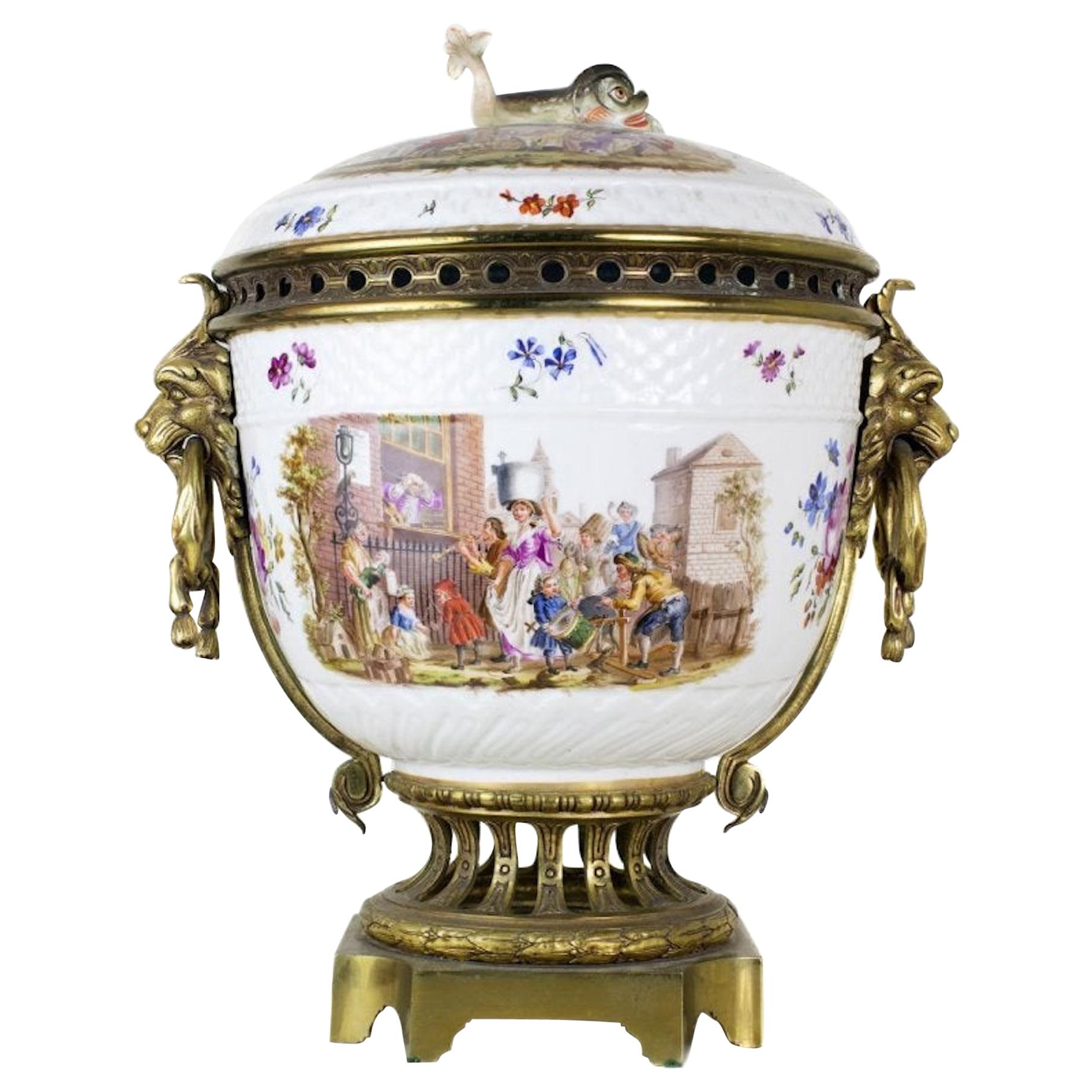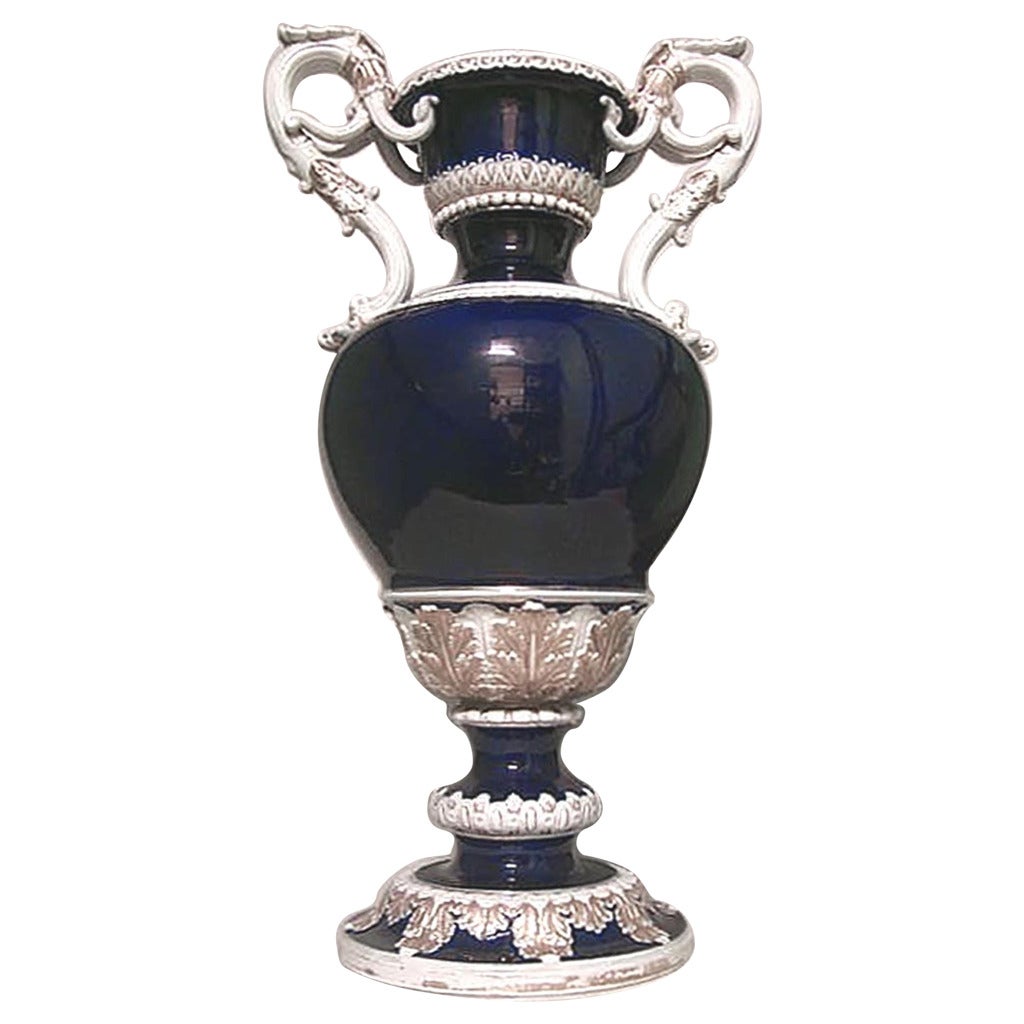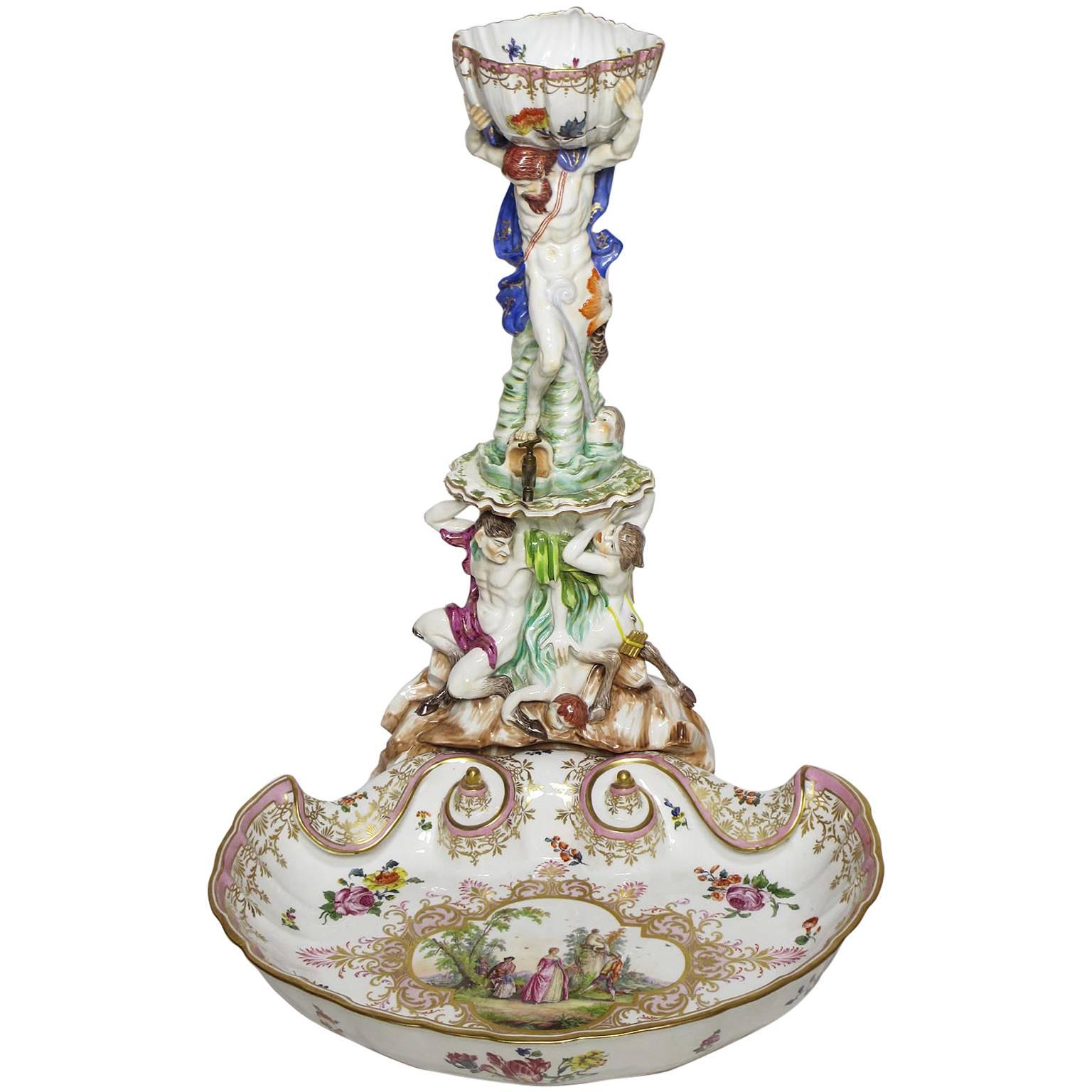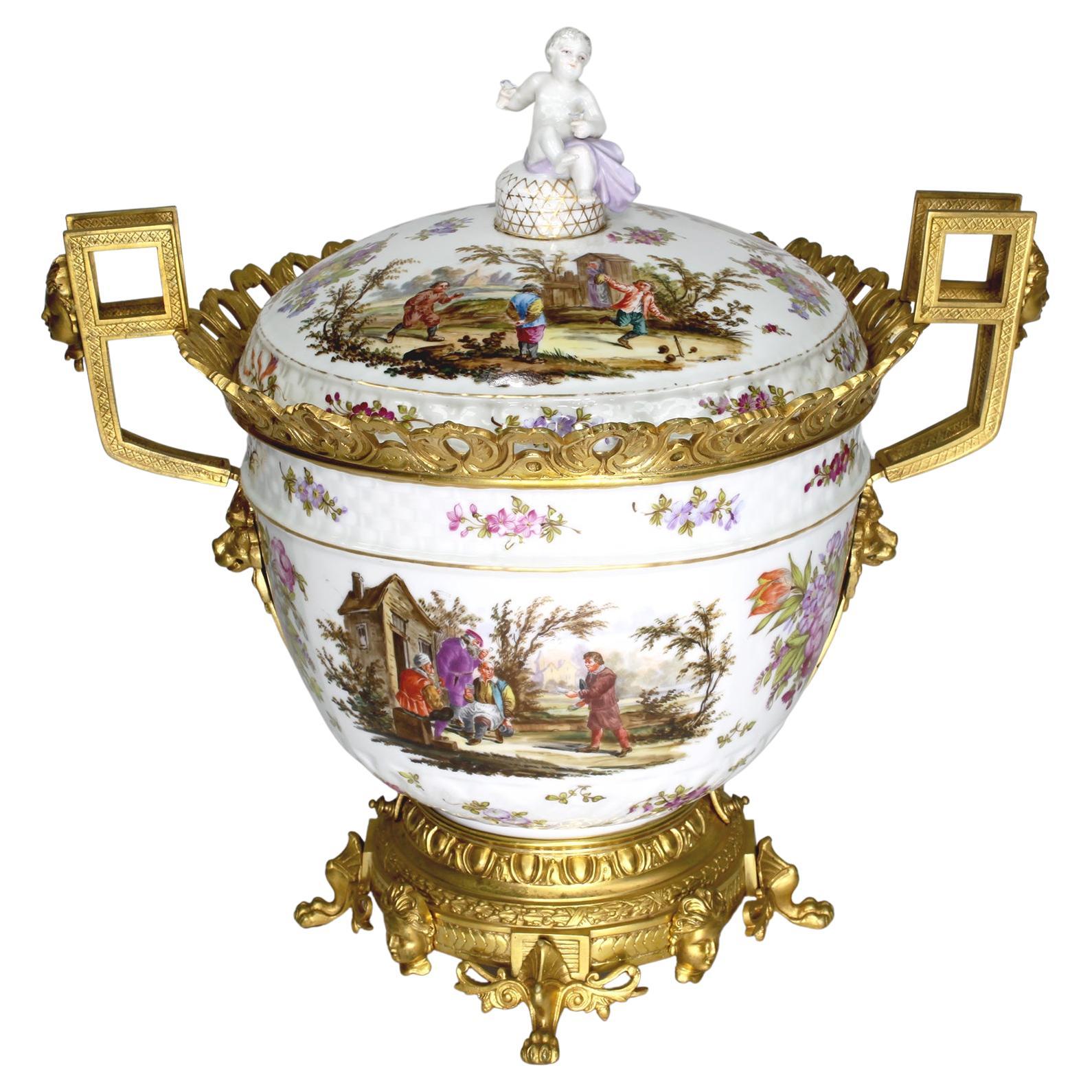Items Similar to Fine German 19th Century Porcelain and Gilt-Bronze Mounted Potpourri Urn Vase
Want more images or videos?
Request additional images or videos from the seller
1 of 17
Fine German 19th Century Porcelain and Gilt-Bronze Mounted Potpourri Urn Vase
About the Item
A very fine German 19th century porcelain and gilt-bronze mounted Potpourri Urn-Vase with Lid, attributed to Meissen. The ovoid white porcelain urn, decorated on all sides and lid with outdoor Country scenes of the hunting life, with peasants, horses, falcons, dogs, preys and flowers, all surmounted on an Imperial gilt-bronze plinth with lion-paw-feet and centered with a burning flame. The lid supported with an intricate pierced ormolu apron with a laurels and shield motif and twin branches, the top with an ormolu acorn with acanthus leaves. circa: 1880
Height: 26 1/4 inches (66.7 cm)
Diameter: 14 1/8 inches (35.9 cm)
Meissen Porcelain or Meissen china was the first European hard-paste porcelain. Early experiments were done in 1708 by Ehrenfried Walther von Tschirnhaus. After his death that October, Johann Friedrich Böttger continued von Tschirnhaus's work and brought this type of porcelain to the market, financed by Augustus the Strong, King of Poland and Elector of Saxony. The production of porcelain in the royal factory at Meissen, near Dresden, started in 1710 and attracted artists and artisans to establish, arguably, the most famous porcelain manufacturer known throughout the world. Its signature logo, the crossed swords, was introduced in 1720 to protect its production; the mark of the swords is reportedly one of the oldest trademarks in existence.
Dresden Porcelain (or "china") was once the usual term for these wares, until in 1975 the Oberlandesgericht (Higher Munich State Court) decided in favour of the Saxon Porcelain Manufactory Dresden, which alone was then allowed to use the name Dresden Porcelain (it ceased producing in 2020).
Meissen remained the dominant European porcelain factory, and the leader of stylistic innovation, until somewhat overtaken by the new styles introduced by the French Sèvres factory in the 1760s, but has remained a leading factory to the present day. Among the developments pioneered by Meissen are the porcelain figurines, and the introduction of European decorative styles to replace the imitation of Asian decoration of its earliest wares.
Since 1991, the manufactory has been operating as the Staatliche Porzellan-Manufaktur Meissen GmbH, whose owner is the Free State of Saxony. The company is one of the world's leading porcelain manufacturers and one of the oldest and most internationally known German luxury brands.
Beginning:
Chinese porcelain had gradually developed over centuries, and by the seventeenth century both Chinese and Japanese export porcelain were imported to Europe on a large scale by the Dutch East India Company and its equivalents in other countries. It was a very expensive product by the time it reached European customers, and represented wealth, importance and refined taste in Europe. European attempts to produce porcelain, such as the brief experiment that produced Medici porcelain in Florence, had met with failure.
At the beginning of the eighteenth century Johann Friedrich Böttger pretended he had solved the dream of the alchemists, to produce gold from worthless materials. When King Augustus II of Poland heard of it, he kept him in protective custody and requested him to produce gold. For years Johann Friedrich Böttger was unsuccessful in this effort.
At the same time, Ehrenfried Walther von Tschirnhaus, a mathematician and scientist, experimented with the manufacture of glass, trying to make porcelain as well. Crucially, his ingredients included kaolin, the vital ingredient of true porcelain, though he was unable to use it successfully. Tschirnhaus supervised Böttger and by 1707 Böttger reluctantly started to help in the experiments by Tschirnhaus.
When Tschirnhaus suddenly died, the recipe apparently was handed over to Böttger, who within one week announced to the King that he could make porcelain. Böttger refined the formula and with some Dutch co-workers, experienced in firing and painting tiles, the stage was set for the manufacturing of porcelain. In 1709, the King established the Royal-Polish and Electoral-Saxon Porcelain Manufactory (Königlich-Polnische und Kurfürstlich-Sächsische Porzellan-Manufaktur), placed Böttger's laboratory at Albrechtsburg castle in Meissen and production started officially in 1710.
Early Work:
The first type of ware produced by Böttger was a refined and extremely hard red stoneware known as "Böttger ware" in English (in German: Böttgersteinzeug). This copied Chinese Yixing ware, and like that was especially used for teapots, and now coffee pots. Similar wares had been made by the Dutch and the Elers brothers in England. Böttger's version was harder than any of these, and retained very crisp definition in its cast or applied ("sprigged") details, on bodies that could be polished to a gloss before firing. Models were derived from Baroque silver shapes and Chinese ceramic examples. There was also a softer stoneware, which was glazed and decorated. Meissen's production of a hard paste white porcelain that could be glazed and painted soon followed, and wares were put on the market in 1713.
Dish with Chinese scene and laub- und bandelwerk surrounds, 1720s
Böttger's experimental wares rapidly gained quality but never achieved successful painted and fired decor. The first successful ornaments were gold decorations applied upon the fired body and finely engraved before they received a second firing at a lower temperature. The lacy frameworks outside painted scenes known in German as Laub- und bandelwerk in red, gold or puce, were often used. Augustus II charged first Johann Jakob Irminger with the design of new vessels. In 1720 Johann Gregor Herold became the director and in 1723 introduced brilliant overglaze colours that made Meissen Porcelain famous, with an increasingly broad palette of colors that marked the beginning of the Classic phase of Meissen Porcelain. His enamel paints are still the basis for ceramic paints today. Initially painting mostly imitated the oriental designs known from Chinese and Japanese export porcelain, but some European landscape scenes were painted from early on.
The signature underglaze "Meissen Blue" was introduced by Friedrich August Köttig. Soon minutely detailed landscapes and port scenes, animals, flowers, galante courtly scenes and chinoiseries, fanciful Chinese-inspired decorations, were to be found on Meissen Porcelain. The Kakiemon floral decoration of vases and tea wares in Japanese export porcelain were combined with Chinese famille verte to create a style known as Indianische Blume ("Indian Flowers"); Augustus had large collections of both Chinese and Japanese porcelain. Coloured grounds with decoration painted on white in panels appear in the 1730s. Paintings by Watteau were copied. Wares were also sold with plain glazed colors, usually white, to be enamelled in private workshops (Hausmalerei), many in Augsburg and Bayreuth, and independently retailed. The support of Augustus' patronage attracted to Meissen some of the finest painters and modellers of Europe as staff artists.
- Attributed to:Meissen Porcelain (Manufacturer)
- Dimensions:Height: 26.25 in (66.68 cm)Diameter: 14.13 in (35.9 cm)
- Style:Regency Revival (In the Style Of)
- Materials and Techniques:
- Place of Origin:
- Period:
- Date of Manufacture:circa: 1880
- Condition:Wear consistent with age and use. Minor fading. A truly stunning porcelain and ormolu mounted vase. Overall condition is very good with almost no wear on the porcelain. The ormolu with its original mercury gilt with some gilt age wear from rubbing, mainly on the base plinth. Please view all images.
- Seller Location:Los Angeles, CA
- Reference Number:
About the Seller
5.0
Vetted Seller
These experienced sellers undergo a comprehensive evaluation by our team of in-house experts.
Established in 1982
1stDibs seller since 2016
114 sales on 1stDibs
Typical response time: <1 hour
- ShippingRetrieving quote...Ships From: Los Angeles, CA
- Return PolicyThis item cannot be returned.
More From This SellerView All
- Fine and Rare German 19th Century Figural Porcelain Liquor Dispenser FountainBy Meissen PorcelainLocated in Los Angeles, CAA very fine and rare German, 19th century figural porcelain liquor dispenser fountain. The two-part allegorical Baroque style fountain depicting a sta...Category
Antique 19th Century German Baroque Revival Porcelain
MaterialsBronze
- Large German Porcelain & Gilt-Bronze Mounted Urn with Cover in Manner of MeissenBy Meissen PorcelainLocated in Los Angeles, CAA Large German 19th/20th century Figural Porcelain and Gilt-Bronze Mounted Urn with Cover in the Manner of Meissen. The ovoid porcelain hand painted u...Category
Antique Early 1900s Baroque Revival Urns
MaterialsBronze
- Fine Pair of French 19th Century Marble and Gilt Bronze-Mounted Flambeaux UrnsLocated in Los Angeles, CAA fine pair of French 19th century Rouge-Royal marble and figural gilt bronze-mounted flambeaux urns surmounted with four ormolu figures of dolphins supporting the center urn with th...Category
Antique 19th Century French Louis XV Urns
MaterialsMarble, Bronze
- French 19th-20th Century Louis XV Style Marble and Gilt Bronze-Mounted Urn LampLocated in Los Angeles, CAA fine French 19th-20th century Louis XV style Brêche violette marble and gilt bronze-mounted figural urn (Now a lamp). The ovoid marble body surmounted with twin gilt bronze figures...Category
Antique Early 1900s French Louis XV Table Lamps
MaterialsMarble, Bronze
- 19th Century Onyx and Ormolu-Mounted Orientalist Urn, Attributed Eugène CornuBy Eugène CornuLocated in Los Angeles, CAA large and impressive French 19th century onyx and ormolu-mounted Orientalist style figural urn, Attributed to Eugène Cornu (French, d. 1875) and G. Viot...Category
Antique 19th Century French Revival Urns
MaterialsOnyx, Bronze
- French 19th Century Napoleon III Sévres Style Porcelain and Ormolu Mounted UrnBy Manufacture Nationale de SèvresLocated in Los Angeles, CAA very fine French 19th Century Napoleon III Sévres Style Porcelain and Ormolu Mounted Covered Urn, the 360 degree painted urn centered with an 18th century scene of a young Princess...Category
Antique 19th Century French Louis XV Porcelain
MaterialsOrmolu
You May Also Like
- Continental Gilt-Bronze Mounted Porcelain Potpourri, Late 19th CenturyLocated in West Palm Beach, FLA continental gilt-bronze mounted porcelain potpourri Late 19th century, The large round-form body topped by a domed lid and dolphin finial, the whole painted with satiric dinner scenes...Category
Antique 19th Century Urns
MaterialsPorcelain
- Large 19th Century German Gilt-Trimmed Meissen Porcelain VaseBy Meissen PorcelainLocated in New York, NY19th century German large blue and white Meissen porcelain vase with gilt trim and scroll handles.Category
Antique 19th Century German Napoleon III Porcelain
MaterialsGold
- 19th Century Bronze Mounted / Porcelain Covered UrnsLocated in Tarry Town, NY19th century French Sèvres-style porcelain gilt bronze mounted covered decorative urns / vases with gilt gold painted scene design details. Each urn is in good condition with wear co...Category
Antique 1850s French Urns
MaterialsBronze
- 19th Century Gilt Bronze / Porcelain Pair UrnLocated in Tarry Town, NY19th century gilt bronze mounted hand painted and crafted porcelain pair decorative covered urn / vase. Each urn features decorated figural design with bronze side handles with Greek mythological scenes. Each one in great antique. Minor wear consistent with age. Undersigned with blue beehive mark...Category
Antique 1830s Austrian Urns
MaterialsGold, Bronze
- 19th Century Pair / Gilt Bronze Mounted Imari Porcelain VasesLocated in Tarry Town, NYEarly 19th century pair of gilt bronze mounted imari porcelain decorative vases or urns. Each urn is in good antique condition with minor wear consistent...Category
Antique Early 19th Century European Urns
MaterialsBronze
- 19th Century Porcelain Gilt Bronze Three-Piece GarnitureLocated in Tarry Town, NY19th century Regency revival porcelain with gilt bronze mantel clock on stand with a pair of neoclassical revival ormolu mounted one handled am...Category
Antique Early 1800s French Regency Revival Mantel Clocks
MaterialsBronze
Recently Viewed
View AllMore Ways To Browse
German 19 Th Century Porcelain Vase Or Pitcher
19th Century Porcelain Vase
Porcelain With Bronze
German Gilt
Porcelain France Vases
Antique Chinese Porcelain Vase Porcelain
Antique Chinese Porcelain Vases Vase Porcelain
Vase Porcelain Gold
Ceramic And Porcelain Vase
Porcelain And Gilt Bronze
Vase Porcelain With Decoration
Antique White Porcelain Vases
Gold Bronze And Porcelain
Bronze Mounted Porcelain
Antique Porcelain Flower Vase
Porcelain And Bronze Mounted
Porcelain Feet
Fine China And Porcelain




